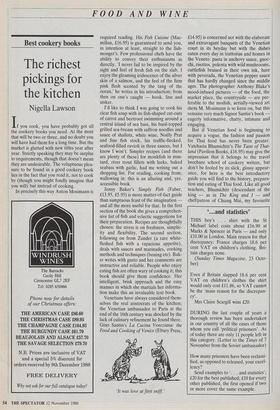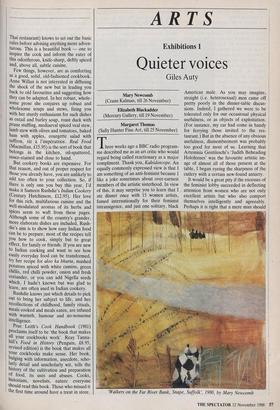FOOD AND WINE
Best cookery books
The richest pickings for the kitchen
Nigella Lawson
If you cook, you have probably got all the cookery books you need. At the most that will be two or three, and no doubt you will have had them for a long time. But the market is glutted with new titles year after year. Strictly speaking they may be surplus to requirements, though that doesn't mean they are undesirable. The voluptuous plea- sure to be found in a good cookery book lies in the fact that you read it, not to cook by (though you might fondly imagine that you will) but instead of cooking.
In precisely this way Anton Mosimann is required reading. His Fish Cuisine (Mac- millan, £16.95) is guaranteed to send you, in intention at least, straight to the fish- monger's. Few professional chefs have the ability to convey their enthusiasms as directly. 'I never fail to be inspired by the sight and feel of fresh fish on the slab. I enjoy the gleaming iridescence of the silver skin of a salmon, and the feel of the firm pink flesh scented by the tang of the ocean,' he writes in his introduction; from then on one's caught — hook, line and sinker.
I'd like to think I was going to cook his clear fish soup with its fish-shaped cut-outs of carrot and beetroot swimming around a central island of sea bass, his basil-topped grilled sea-bream with saffron noodles and sauce of shallots, white wine, Noilly Prat and fine fish stock, his truffle-flecked, seafood-filled ravioli in three sauces, but I know I won't. Simpler recipes (and there are plenty of these) for monkfish in mus- tard, river trout fillets with leeks, baked seabass with garlic, had me writing out a shopping list. For reading, cooking from, wallowing in: this is an alluring and, yes, accessible book.
Jenny Baker's Simply Fish (Faber, £13.95, £5.95) is more matter-of-fact guide than sumptuous feast of the imagination — and all the more useful for that. In the first section of the book she gives a comprehen- sive list of fish and eclectic suggestions for their preparation. Recipes are thoughtfully chosen: the stress is on freshness, simplic- ity and flexibility. The second section, following on from Zander (a rare white- fleshed fish with a rapacious appetite), deals with sauces and marinades, cooking methods and techniques (boning etc). Bak- er writes with gusto and her comments are instructive and reliable. People who enjoy eating fish are often wary of cooking it; this book should give them confidence. Her intelligent, brisk approach and the easy manner in which she martials her informa- tion make this an invaluable text book.
Venetians have always considered them- selves the real aristocrats of the kitchen; the Venetian ambassador to Paris at the end of the 16th century was shocked by the lack of culinary refinement he found there. Gino Santin's La Cueina Veneziano: the Food and Cooking of Venice (Ebury Press,
'It was love at first sniff.' £14.95) is concerned not with the elaborate and extravagant banquets of the Venetian court in its heyday but with the dishes eaten every day in trattorias and homes in the Veneto: pasta in anchovy sauce, gnoc- chi, risottos, polenta with wild mushrooms, cuttlefish braised in their own ink, hare with peverada, the Venetian pepper sauce that has hardly changed since the middle ages. The photographer Anthony Blake's mood-infused pictures — of the food, the market place, the countryside — are pre- ferable to the modish, aerially-viewed art shots M. Mosimann is so keen on, but this remains very much Signor Santin's book — eagerly informative, chatty, intimate and engaging, But if Venetian food is beginning to acquire a vogue, the fashion and passion for Thai food has never been greater. Vatcharin Bhumichitr's The Taste of Thai- land (Pavilion Books, £16.95) may give the impression that it belongs to the travel brochure school of cookery writers, but don't be fooled by its slick, glossy appear- ance, for here is the best introductory guide you will find to the history, prepara- tion and eating of Thai food. Like all good teachers, Bhumichitr (descendant of the king — as in The King and I — and chef/patron of Chiang Mai, my favourite Thai restaurant) knows to set out the basic rules before advising anything more adven- turous. This is a beautiful book — one to inspire the cook and inform the eater of this odoriferous, knife-sharp, deftly spiced and, above all, subtle cuisine.
Few things, however, are as comforting as a good, solid, old-fashioned cookbook. Anne Willan is not interested in diffusing the shock of the new but in leading you back to old favourites and suggesting how they can be adapted. In her robust, whole- some prose she conjures up robust and Wholesome soups and stews, firing you with her sturdy enthusiasm for such dishes as oxtail and barley soup, roast duck with Prune stuffing, mediaeval spiced veal stew, lamb stew with olives and tomatoes, baked ham with apples, courgette salad with saffron, riz a l'imp6ratrice. Real Food (Macmillan, £15.95) is the sort of book that belongs in the kitchen, oil-spattered, sauce-stained and close to hand.
But cookery books are expensive. For that reason, and out of proper respect for those you already have, you are unlikely to add too often to your collection. So, if there is only one you buy this year, I'd make it Sameen Rushdie's Indian Cookery (Century Hutchinson, £12.95). Her love for this rich, multifarious cuisine and the well-modulated aromas of its herbs and Spices seem to waft from these pages. Although some of the country's grander, more elaborate dishes are included, Rush- die's aim is to show how easy Indian food can be to prepare; most of the recipes tell You how to cook, simply but to great effect, for family or friends. If you are new to Indian cooking and want to see how easily everyday food can be transformed, try her recipe for aloo ka bhurta, mashed Potatoes spiced with white cumins, green chillis, red chilli powder, onion and fresh coriander, or you can add Nigella seeds Which, I hadn't known but was glad to learn, are often used in Indian cookery.
Rushdie knows just which details to pick out to bring her subject to life, and her recollections of childhood, family rituals, meals cooked and meals eaten, are infused With warmth, humour and no-nonsense intelligence.
Prue Leith's Cook Handbook (1981) proclaims itself to be 'the book that makes all your cookbooks work'. Reay Tanna- hill's Food in History (Penguin, £8.95, revised edition) is the book that makes all Your cookbooks make sense. Her book, bulging with information, anecdote, scho- larly detail and unscholarly wit, tells the history of the cultivation and preparation Of food, its uses and abuses. Cooks, historians, novelists, eaters: everyone 'Should read this book. Those who missed it the first time around have a treat in store.











































































 Previous page
Previous page